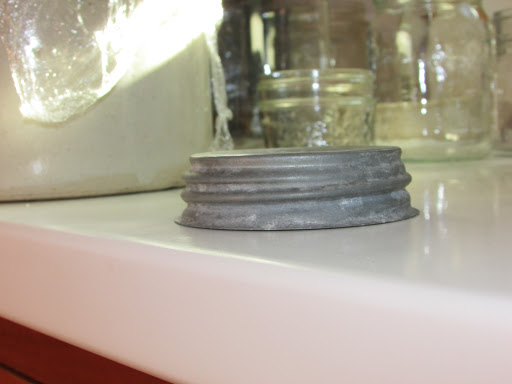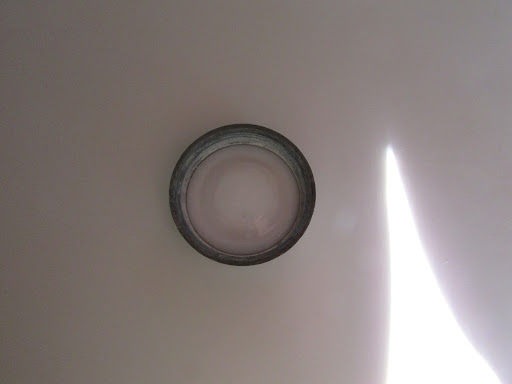I am NOT recommending that anyone can with zinc lids. The safest way to can foods at home is to use the flat metal dome lids that have the sealing compound attached to the outer rim. I find that kind of lid to be extremely convenient and reliable, and the "ping" that you hear as they seal is one of the most rewarding sounds that I know. They are definitely my favorite canning lids to use.
After I started writing my last post about canning with glass lids, I had to do my Covid-altered grocery run, and Nancy and I made a trip to our closest formerly-Amish stores. I've talked to a few others too, and the current canning lid shortage is confirmed. In fact, one of our friends told us that her canning lid supplier--a very fascinating Mennonite store named The Dutchman in Cantril, Iowa--called her and told her that they would not be able to get canning lids until September! My thinking is, with the way 2020 has gone so far, what's to say they will even be able to get them then?
And so, while I'm not advocating canning with anything other than new dome lids, it seems like knowing how to can using other types of canning lids might be a prudent skill to have right now. Plus, friends, zinc lids seem to be EVERYWHERE. You frequently see them at antique stores, second-hand stores, and estate sales; and, if you're like us and living in a farmhouse that has been in the same family for generations, there is likely a stack of these in your basement. If you can't find them in these places, never fear; Ebay has a ton of them too.
You will also need rubber sealing rings. These don't seem to be as plentiful as the lids, but that's all right because they are still available new. I see them in Amish stores, and Lehman Hardware currently carries them, too. You can buy them here: https://www.lehmans.com/product/standard-old-style-canning-jar-rubbers/ They also carry wide-mouth ones. The rubber rings used with zinc lids come in two styles: with a tab and without a tab. I see the ones with a tab far more often.
The kicker with zinc lids, though, is that you need to have older canning jars. Whereas nowadays the sealing edge is the top lip of the jar, it used to be down on the shoulder. The new style canning jars don't have a sufficiently wide shoulder to create a seal.
 |
| Two Kerr canning jars. This is not the best example, but the one on the left is older and has the wider shoulder. The jar on the right is newer, and you can see that the shoulder has been reduced. |
Before using zinc lids, inspect them carefully. Zinc is a pretty malleable metal, so these lids can be a bit susceptible to damage--especially after decades of use. They should not bulge up in the center, and when you lay them right side up on a flat surface, the bottom edge of the lid should sit flat all the way around. Also, look on the underside of the lid and make sure that the white piece of milk glass is present. I don't know how it could fall out, but apparently it happens.
 |
| This is an example of a lid that is in good shape. Notice how the edge sits on the counter all the way around. |
 |
| A view showing the milk glass on the inside of a zinc lid. |
To prepare zinc lids for canning, both the lids and the rubber rings need to be thoroughly washed and then scalded. They are to remain in hot water until used. Some vintage canning books recommend the lids (not the rubber rings) actually be boiled for anywhere between ten and thirty minutes before use, and with this sort of lid, that would be fine, too.
 |
| A zinc lid and rubber ring sitting in scalding water on the Margin Gem. It was so cool here a week ago today (Aug. 4) that I fired up the Margin Gem and did the day's canning in the house. |
Once your jars are packed with whatever you are canning, the first step is to stretch a rubber ring over the top of the jar and seat it down on the shoulder.
Screw the zinc lid down as firmly as you are able; then unscrew the lid a quarter inch.
Place the jar in the canner and process according to what is required for the food you are canning.
Immediately upon removal from the canner (you shouldn't let jars remain in a pressure canner to cool once the pressure has gone down), tighten the lid down as much as you can.
Testing to see whether you have a good seal is not all that easy with zinc lids. This is probably why they fell out of favor. The top of the lid should have a slightly concave shape. Once the jar is completely cool, you can also turn the jar upside down or on its side to check for leaks. If it leaks, you definitely don't have a good seal and need to start the whole canning process over.
I canned a jar of food using zinc lids with my grandma Marian once. When she had first started canning on her own, these were the lids of choice, so she knew what she was doing. She reminisced about her own mother using them, saying that Grandma Gladys kept a small hammer in the kitchen and tapped around the edges of the lids once the jars were cool to make sure they had a good seal. I can't think that this was at all helpful.
To open the jar when you are ready to eat its contents, you can pull the tab to break the seal and then unscrew the lid, or you can just unscrew the lid. I would advise listening for that telltale sign of a good, safe vacuum which is the sound of air rushing into the jar when you open it.
Again, I wouldn't advise canning with zinc lids if you don't have to. But if you have to, it's best to know how to do it properly.





What a wonderfully timely post! I so appreciate the time and information shared. So, the zinc lids are safe? I have a few so this is great news!
ReplyDeleteHi, Momma Bear!
DeleteThe short answer is "yes," but I would advise the following:
a) Be extra vigilant about watching for spoilage in jars that you've sealed this way.
b) Carefully follow all current canning guidelines for pounds of pressure, processing times, etc.
c) When you open a jar for use, always listen carefully for the vacuum breaking. If you don't hear that, be very suspicious of the food.
d) Follow guidelines for boiling low-acid foods once they have been opened and before use or tasting.
Could you hot pack with the zinc lids, less concern about the seal failing, but would it form a seal?
ReplyDeleteHi, Tristian! Welcome to my blog and thank you for your question.
DeleteYes, I believe it would seal. Just follow all of the cautions listed above, though!
I found a whole box of never used 1979 Ball Zinc caps at an estate sale-with the box! I just plan on using them to store my dehydrated things this year!!!! I was a little thrown about the seals! It is tough being a newbie to canning! Thanks for all the good information!!!
ReplyDeleteWhat a great find! I tell you what: within the last two weeks, I have been to an Ace Hardware, a Target, and two supermarkets, and there are STILL no canning lids to be had. The zinc and glass lids are looking more and more viable to me for the upcoming season!
DeleteYou can order from the Ball website.. .com address.
ReplyDeleteI appreciate this info very much! I have always wondered how they worked! That said, I will highly recommend Tattler reusable canning lids! I use them and LOVE them, and I feel so liberated from single use dome lids!!!! Happy canning!
ReplyDeleteERROR! The page states to "unscrew the lid a quarter inch." You will NOT do this. You unscrew the lid A QUARTER TURN!
ReplyDeleteAfter receiving this comment, I checked my antique Ball Blue Books. Both of them say to unscrew the lid 1/4 inch. This does not mean that the whole lid should rise a quarter inch from the rubber ring. Rather, if a line were drawn down the outer side of the lid, the lid would be turned until that line moved to the left a quarter inch. This would be perhaps an inch less than what a full quarter turn would result in.
DeleteThank you so much for taking the time to share this information. I have many of those older jars and lids and never actually understood the process. I may have to make something just to say I actually did it. Probably something like jam and use up quickly. I just want to see it work!
ReplyDelete